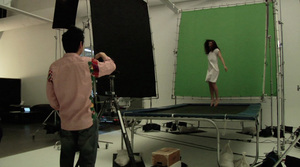Kirsten Tan has often stood on the side of the loner,
whether in her various award-winning short films or in her Sundance-celebrated
feature film Pop Aye (also reviewedin this month’s STOP10). Consider her most recent fiction films, for instance,
which take an introspective glimpse into the life of an elderly widow on Pulau
Ubin, or a wheelchair-bound NYC eccentric, or a disillusioned Thai architect on
a road trip. But Tan’s affinity for the reserved protagonist also carries into
her documentary work, notably in her 2012 short film John Clang, which centres on the NYC-based Singaporean visual
artist and photographer of the same name.
In many respects, John Clang fits naturally as a documentary
subject into Kirsten Tan’s filmography, perhaps due to some clear similarities that
they share:
1) They are both Singaporean
art-makers who have wound their way to New York City, but who remain staunchly Singaporean.
The theme of displacement threads itself through Kirsten Tan’s work across various
registers, from as light-hearted as a man trapped in his boxers on his fire
escape (Cold Noodles) to as serious
as an ill-fated encounter with a Rohingyan refugee girl (Dahdi). In John Clang, this
theme takes yet another shape, in the figure of Clang at work in a featureless
NYC photography studio, surrounded by blank walls and green screens. As Clang tells
it, New York exists for him mainly as a ‘cave’ in which he can focus on his
work. “Hearing from my accent and knowing me, I’m very much living in Singapore
mentally,” narrates Clang in his Singlish-inflected voiceover.
John Clang thus
offers up a different narrative of the displaced Singaporean artist, in which leaving
Singapore is not necessarily a sign of enmity towards the country, as much as
it is an opportunity to find one’s voice. Clang’s voice speaks for itself, both
in his accent and in his work, and Tan wisely lets him do it throughout the
film. Likewise, Tan’s own journey brought her through South Korea, Thailand and
the US, and yet here she maintains a similar fidelity to her hometown in her
loving use of old footage of a former Singapore: drive-by shots of movie
billboards over the former Capitol Theatre, or clips of humble HDB flats with
their old metal shutters and bamboo poles.
2) They both work in
visual media, and tap on a surrealist vein in their artwork. Clang’s
projects echo the quiet and surrealist aesthetic of Tan’s filmography. Various
images of hers float to mind: a solitary bathroom sink standing in the ocean in
Sink; a camera’s quiet swoop down a muddy
river flanked by greenery in Dahdi;
or now, most famously, a man heading down a country road with an elephant
companion in Pop Aye.
Of course, since John
Clang is structured primarily as a retrospective of Clang’s artistic
portfolio, Tan focuses primarily on offering a delightful sampler of his work. We
get glimpses of Clang’s eye for a slightly alien beauty: a girl in a white
nightslip drifting serenely over a sun-dappled redwood forest, or a mandrill in
a lush zoo habitat surrounded by out-of-focus bubbles of NYC passersby. Other
conceptual works get the elaboration they deserve: take, for instance, Clang’s
poignant series of portraits of overseas Singaporeans taken with a projected
backdrop of their families back home. Or his Twilight Dreams of Papilio Demoleus series, in which two cameras
are triggered simultaneously to capture two angles on the same cityscape, with
a lone butterfly superimposed on one of the two panels to inspire the viewer’s
contemplation.
3) They both
celebrate and enjoy solitude as a respite from the modern world. Against
the grain of our social media-saturated age, John Clang offers a lovely portrait of an artist who feels no
compunction to being extroverted. On the contrary, Clang claims that his
introversion is crucial to his success as an artist, since it allows him to
observe other people and capture details about them in his work. This manifests
plainly in his photograph series Strangers,
in which he digitally manipulates people on the streets of New York to place
them in a room. “I’m actually quite a shy guy,” admits Chang with a laugh.
“When they’re about to speak, I run away.”
Tan has also made no bones about her own brushes with solitude.
In a Straits Times interview earlier this year, she shares about how loneliness
“made me sensitive to everything. I became more observant. Snow falling felt
more beautiful.” In John Clang, then,
we witness a paean from one artist to another: kindred spirits, far from home but
still at home, looking at the world askew, and finding a quiet beauty.
John Clang is available for viewing on Viddsee's Singapore Film channel.
John Clang is available for viewing on Viddsee's Singapore Film channel.
Written by Colin Low
For the full list of April 2017's 10 films under STOP10, click here.




